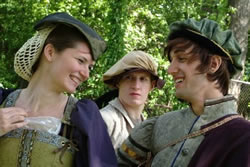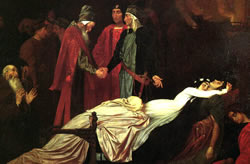Lesson 5.2A: Act I
This lesson has two purposes. The first is to get you set up to view the DVD and start thinking about your module project. Secondly, this lesson will fully immerse you in to Act I of the play!
 Here's some context to Act I to get you started. Here's some context to Act I to get you started.
In fair Verona:
- Two young men, looking for trouble, are swaggering down a city street.
- They insult one another and brag about how strong they are.
- Some other men, from a rival gang, approach.
- These gangs, one associated with the Capulet family and the other with the Montagues, are sworn enemies.
- This can only lead to trouble, and it does when the two leaders approach and both sides begin to goad each other into a fight.
- More trash talking happens, and soon swords are drawn, blood is spilled, and innocent bystanders are hurt.
- The law arrives, breaks up the brawl, and threatens severe punishment if anything like this happens again.
Shakespeare begins Romeo and Juliet with a bang, something to get the audience's attention-a mass brawl!
| Discussion Prompt |
Shakespeare is a master of his craft. He wants to get his audience interested in the play immediately, and he does this by giving them what they want, something intense and violent, something with impact. Movie directors today do the same thing. They want you to watch, so they grab your attention.
How many movies or television shows have you seen that begin in this way, with a bang? |
Guidelines for contribution:
Identify at least one movie or TV show you know that begins with a bang. Identify the name of the show, and describe what happens at the beginning. As well, explain how this grabs your attention. Read the postings by at least two other students.
Click here to make your contribution to the forum. |
Getting Set Up for the Section
In this section, you will read selected excerpts from the text version of the play, but you will watch the entire DVD version of Romeo and Juliet. This is important, because, as a drama, Shakespeare intended his play to be viewed!
What Will I Need to Know?
Viewing the video and reading selected excerpts may seem overwhelming at first. But don't be alarmed; you will not be expected to know or remember all the details.
Here are areas you need to focus on:
- a basic understanding of the plot
- the personality characteristics of the main characters
- important conflicts, images, and themes
- some grasp of Shakespeare's English
Thinking Ahead
Your Module Project will be to write a movie review of Romeo and Juliet, so have pen and paper ready to take down some notes as you watch.
Here are some questions to consider:
- Are the characters believable, realistic?
- Is the acting good for the kind of movie you're watching?
- Does the setting add to the overall movie?
- Can you follow the story, or is it confusing?
- Does the story unfold in such a way as to keep you interested?
- Do you like the movie? Why or why not?
 There are other questions you could ask, and if you think of any, definitely write them down as well. You don't need to spend the whole time jotting down notes, but you will be better prepared for the Module Project if you engage with the movie and jot things down as you watch. Using the following viewing strategies as a guide will help you in this process. There are other questions you could ask, and if you think of any, definitely write them down as well. You don't need to spend the whole time jotting down notes, but you will be better prepared for the Module Project if you engage with the movie and jot things down as you watch. Using the following viewing strategies as a guide will help you in this process.
Viewing Strategies
Film and television deliver messages that affect you in subtle but important ways. If you have critical viewing skills, you can interpret these messages. These skills will also allow you to discuss television and movies more effectively. While some viewers have difficulty explaining what they like or dislike about a movie, critical viewers usually enjoy defending their opinions.
You will not be watching the movie all at once, but rather act by act. So while some of the strategies discussed in the following template might be geared towards watching an entire movie, they can easily be adapted to watching Romeo and Juliet in segments.
Keep a copy of this template close at hand and fill it in as you go.
Do You Bite Your Thumb at Me?
 Read the introduction to Act I, Scene i on page 11 in your text. Be sure to look at the accompanying picture as well to help you visualize the scene. Then, try your hand at reading Act I, Scene i. Use the notations on the left page to guide your understanding. Read the introduction to Act I, Scene i on page 11 in your text. Be sure to look at the accompanying picture as well to help you visualize the scene. Then, try your hand at reading Act I, Scene i. Use the notations on the left page to guide your understanding.
|
As you read, pay attention to how this scene unfolds dramatically: how does the scene move from action and violence to the moody and moping Romeo, a young man in love? This is called contrast.
Pay attention to how Shakespeare uses language. The beginning of this scene is full of quick word play and puns as characters banter back and forth. What about the rest of the scene? Do the word plays and puns change?
In this scene, Shakespeare also establishes two main ideas or themes: the simmering feud and violence that is just below the surface, as well as the notion of love and what it does to some people.

Journal Entry 5.2A: Beginning With a Bang
In the journal section of the assignment tempalte, describe your experience of reading this first scene. Were you able to understand most of the content? Did you feel like you were reading a foreign language? Describe some of the reading strategies you used. Will you continue to use these strategies, or will you try something new as you continue to read?
|
| Discussion Prompt |
Share some strategies for understanding the first scene of the play. |
Guidelines for contribution:
Read at least two other posts and try out the strategies suggested. Click here to add your thoughts to the forum.
|
Act I - Romeo and Juliet
 Watch the first Act of Romeo and Juliet (scenes i-vi on the DVD “Scene Selection” menu). Watch the first Act of Romeo and Juliet (scenes i-vi on the DVD “Scene Selection” menu).
Here's a quick summary of Act I:
Prologue
Shakespeare's begins with a Prologue which establishes that this play will be a tragedy, and that the children of two feuding families, Romeo of the Montague family and Juliet of the Capulet family, will both love and die in the course of this play.
 Act I Act I
Sampson and Gregory, two Capulet servants and Abraham and Balthasar, two Montague servants start a street fight. Benvolio, a Montague and Tybalt, a Capulet arrive and join in. Escalus, the Prince of Verona, learns of this fight, and declares the death penalty for further feuding between the two families. We learn Romeo is lovesick for Rosaline, who will not return his love. His friend Benvolio tells Romeo to look at other girls.
Meanwhile, Capulet is keen for Paris to marry his daughter Juliet and plans a party to be held later that night. Romeo and friends decide to turn up uninvited, with Romeo hoping to see Rosaline, whom he still pines for.
Lady Capulet discusses the idea of marriage to Paris with Juliet. Juliet keeps her options open. The Nurse wishes Juliet every possible happiness.Mercutio attempts to cheer up a lovesick Romeo, telling him to be rough with love if need be.
At Capulet's party, Romeo, who is disguised by a masque, falls in love with Juliet on sight. Juliet is also taken with Romeo. Tybalt sees him and gets very angry, as Romeo is from the “enemy” family. Capulet stops Tybalt from attacking Romeo at his party, saying there will be other opportunities. Both Romeo and Juliet learn that they are each enemies of the other's family.
 A Prologue sung by a chorus dramatizes the conflict both Romeo and Juliet feel between their love for one another and their loyalty to their families. A Prologue sung by a chorus dramatizes the conflict both Romeo and Juliet feel between their love for one another and their loyalty to their families.
Love, the Tangled Web They Weave
Act I introduces the main characters and the moment when Romeo and Juliet meet. Already, complications of this relationship are established.
Near the end of Act I.i you read how Romeo was in love with Rosaline, but she would not return his affection. A good word to describe Romeo at this stage is melancholic - sad, gloomy, and depressed. The only thing that seems to lift his spirits is the fact that he might see Rosaline at Capulet's party. Benvolio, Mercutio, and the others see this as a good opportunity to crash the party. Romeo's fateful decision to sneak into Capulet's masquerade party will set in motion most everything else that happens in Romeo and Juliet.
 Now that you have viewed all of Act I, read the following excerpts closely. As you read these scenes, be sure to make use of the summaries that cover the basic plot, as well as the margin notes, which explain in more detail what words and phrases mean. Now that you have viewed all of Act I, read the following excerpts closely. As you read these scenes, be sure to make use of the summaries that cover the basic plot, as well as the margin notes, which explain in more detail what words and phrases mean.
If you're able, it would be best for you to read through all of Act I, but the key moments are highlighted below. |
Read the following scenes to help you with the rest of this lesson:
- Act I.ii.1-19-Paris asks to marry Juliet
- Act I.ii.82-101-Romeo agrees to sneak into Capulet's party
- Act I.iii.60-100-Juliet learns of Paris' wish of marriage
- Act I.iv.48-114-Mercutio talks of dreams
- Act I.v.42-144-Romeo sees Juliet, Tybalt sees Romeo, and Juliet learns the shocking truth
Note: When referring to a specific part of a Shakespeare play, it is common practice to make reference to act, scene, and line numbers. To do so, use:
- Upper case Roman numerals for acts: I, II, III, IV, V
- Lower case Roman numerals for scenes: i, ii, iii, iv, v
- Regular numbers for lines: 1, 2, 3, 4, 5
So, if the text references II.iii.24 - 26, you know to go to Act II, Scene iii, Lines 24 - 26. You will also reference the text in the same way when you quote a line from the play in your writing. Enclose the notation in parentheses.
For Example: Juliet's statement to Romeo, “It is too rash, too unadvised, too sudden” (II.ii.118) indicates she is aware early in the play that there is something dangerous in their love.
Summary
Completing this lesson has helped you to:
- critically view a movie
- plan ahead for your module project
- understand how the main conflict is introduced in Romeo and Juliet
- see how Shakespeare skillfully builds different emotions or moods through his characters and the situations they encounter
- understand Act I of Romeo and Juliet
|

